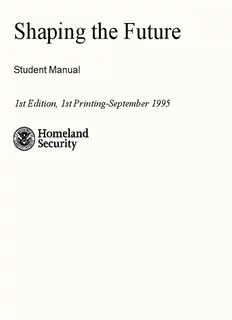
Shaping the Future-Student Manual - State Fire Marshal PDF
Preview Shaping the Future-Student Manual - State Fire Marshal
Shaping the Future STF-Student Manual 2nd Edition, 4th Printing-May 2014 2 n d F E E d M itiMSA onayTF/U , 4th 201-SMSFA P4 /N r F i n A ti n g S h a p i n g t h e F u t u r e Shaping the Future STF-Student Manual 2nd Edition, 4th Printing-May 2014 This Student Manual may contain material that is copyright protected. USFA has been granted a license to use that material only for NFA-sponsored course deliveries as part of the course materials, and it shall not be duplicated without consent of the copyright holder. States wishing to use these materials as part of state-sponsorship and/or third parties wishing to use these materials must obtain permission to use the copyright material(s) from the copyright holder prior to teaching the course. This page intentionally left blank. SHAPING THE FUTURE U.S. DEPARTMENT OF HOMELAND SECURITY UNITED STATES FIRE ADMINISTRATION NATIONAL FIRE ACADEMY FOREWORD The U.S. Fire Administration (USFA), an important component of the Department of Homeland Security (DHS), serves the leadership of this Nation as the DHS's fire protection and emergency response expert. The USFA is located at the National Emergency Training Center (NETC) in Emmitsburg, Maryland, and includes the National Fire Academy (NFA), National Fire Data Center (NFDC), and the National Fire Programs (NFP). The USFA also provides oversight and management of the Noble Training Center in Anniston, Alabama. The mission of the USFA is to save lives and reduce economic losses due to fire and related emergencies through training, research, data collection and analysis, public education, and coordination with other Federal agencies and fire protection and emergency service personnel. The USFA's National Fire Academy offers a diverse course delivery system, combining resident courses, off- campus deliveries in cooperation with State training organizations, weekend instruction, and online courses. The USFA maintains a blended learning approach to its course selections and course development. Resident courses are delivered at both the Emmitsburg campus and the Noble facility. Off-campus courses are delivered in cooperation with State and local fire training organizations to ensure this Nation's firefighters are prepared for the hazards they face. In further support of linkage with established professional fire service organizations, the NFA has agreed to develop field training in cooperation with the Training Resource Analysis and Data Exchange Program (TRADE). One such cooperative project recommended to the NFA by TRADE is to develop training in the subject area of mid- level management for the fire service. TRADE has requested that the Academy develop two 2-day courses for field delivery. The purpose of this training is to provide students with an understanding of concepts, functions, and responsibilities at the intermediate management level, as well as issues affecting mid-level management personnel in the fire service. This course, Shaping the Future, will focus on the skills and techniques that a midlevel manager needs to provide leadership and direction for his or her fire department. The first module will have students focus on identifying opportunities (or problems). This will include discussions on the use of environmental scanning as a tool, the concept of paradigm shifts, and methods to reframe problems accurately. Mobilizing people to solve problems as groups, rather than continually using only the traditional fire service groups is the focus of the second module. It will include topics such as problem-solving strategies, a discussion of benchmarking, and the need to involve resources outside the fire department and government. The third module will focus on the need to quantify, justify, and communicate decisions so they will be implemented effectively. Managing change will be discussed in the final module of the course. Why people resist change, overcoming that resistance, and monitoring and evaluating the change before, during, and after its implementation are topics that will be covered in this module. iii SHAPING THE FUTURE This page intentionally left blank. iv SHAPING THE FUTURE ACKNOWLEDGEMENTS The development of any National Fire Academy course is a complex process aimed at providing students the best possible learning opportunity we can deliver. There are many players in course development, each of whom plays an equally important part in its success. We want to acknowledge their participation and contribution to this effort, and extend our heartfelt thanks for making this quality product. The following persons participated in the creation of this course: Phil Davis Subject Matter Expert Organizational Strategies, Inc. Emmitsburg, MD Dr. Burton Clark, Training Specialist Leadership and Fire Risk Reduction Section United States Fire Administration National Fire Academy Stacey Harmon, Instructional Systems Specialist Leadership and Fire Risk Reduction Section United States Fire Administration National Fire Academy Karen Kent, Contract Program Manager Organizational Strategies, Inc. Emmitsburg, MD Elissa Weeks, Instructional Systems Specialist Organizational Strategies, Inc. Emmitsburg, MD Brendan Weeks, Editor Organizational Strategies, Inc. Emmitsburg, MD v SHAPING THE FUTURE This page intentionally left blank. vi SHAPING THE FUTURE TABLE OF CONTENTS PAGE Foreword ........................................................................................................................................................... iii Acknowledgments ............................................................................................................................................. v Table of Contents .............................................................................................................................................. vii Course Goals ..................................................................................................................................................... ix Target Audiences ............................................................................................................................................... ix Course Overview ............................................................................................................................................... xi Course Schedule ................................................................................................................................................ xiii Firefighter Code of Ethics ................................................................................................................................. xv A Student Guide to End-of-course Evaluations ................................................................................................. xvii MODULE 0: WELCOME AND INTRODUCTION* ..................................................................... SM 0-1 MODULE 1: REDEFINING THE PRESENT ................................................................................. SM 1-1 MODULE 2: FINDING SOLUTIONS IN THE QUALITY ENVIRONMENT ............................ SM 2-1 MODULE 3: JUSTIFYING DECISIONS ........................................................................................ SM 3-1 MODULE 4: MANAGING CHANGE IN THE FIRE SERVICE ENVIRONMENT ........................................................................................................ SM 4-1 MODULE 5: COURSE CONCLUSION ........................................................................................... SM 5-1 * Note that Module 0 contains introductory material to be presented by the instructor and is not included in the Student Manual. vii SHAPING THE FUTURE This page intentionally left blank. viii
Description: